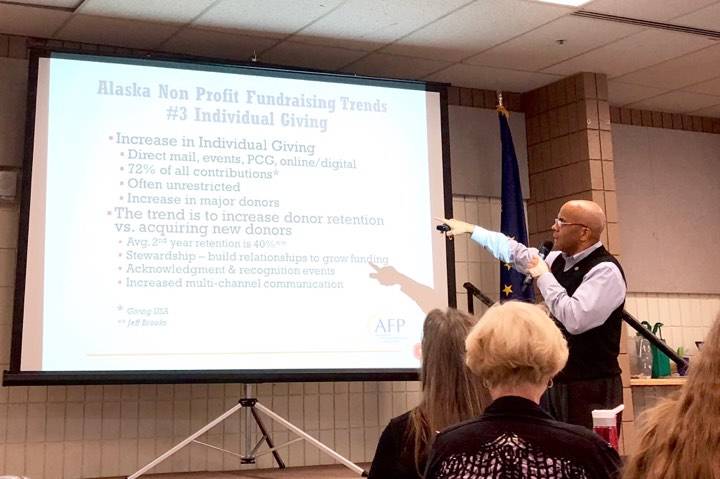Nonprofit support is up across the country, but in Alaska, it’s down, Ken Miller, president of Denali FSP Fundraising Consultants told the audience at the Soldotna Chamber Luncheon on Wednesday.
After graduating from college, Miller, who grew up in Anchorage, said he got involved in drinking and drugs. He said he spent approximately 17 or 18 years as a homeless person and five years behind bars.
“I always like people to understand why I do what I do,” Miller said. “I’m a nonprofit consultant. I love nonprofits. I love what they do. I love how they engage the community and I love the services that they provide for their constituents or beneficiaries.”
He said it’s an interesting time for nonprofits in Alaska.
“The rest of the country is doing great for nonprofits,” Miller said. “Corporate support is up, individual support is up and foundation support is up. In Alaska, we have some problems.”
National nonprofit donations are up 5.2 percent from last year, Miller said, with Americans contributing $410 billion to nonprofits. More than 31 percent of that money is going to religious organizations, followed by 14 percent contributing to education organizations and then 12 percent going toward human services.
The two largest nonprofits in the state are the University of Alaska Foundation and Providence.
A combination of a decrease in federal and state funding dollars, increased competition, new reporting requirements, and a decrease in corporate support are reasons why donation spending in Alaska is down, he said. There is an increase in foundation support, he said.
“I’m going to be real frank, but we don’t really have that many good people in this state,” Miller said. “I’m talking about competent people in the area of fundraising and nonprofit leadership.”
When it comes to state and federal funding dollars, Miller said the increase in competition makes it harder for nonprofits to receive their goal amount or any money at all. He said the state deficit has taken a toll on state grant programs.
“Let me tell you, the money (for grants) is gone,” Miller said. “It’s not even being cut. It’s gone.”
He encouraged nonprofits to turn away from government grants.
“What you want to do is to cut away from relying on one source of income,” Miller said. “That’s the key.”
New rubric for reporting has made it difficult for some nonprofits to retain certain grants, he said.
“Back in the day they just gave you the money and said ‘God bless,’” Miller said. “It is complex and if you don’t (report) well, you don’t get the money. A lot of times when nonprofits don’t get grants and money it’s because of bad reporting or no reporting.”
When oil prices went down, a ripple effect followed, which resulted in a decrease of corporate donations, he said.
He said the foundations are increasing their spending on nonprofits because the market is up.
“Their money comes from the market,” Miller said. “Their money went up and whatever their body of money is they have to give away a percentage of it.”
Now that the economy is up, so is individual giving, Miller said.
The way nonprofits are receiving their donations is changing too. Miller said 14 percent of all donations come through a digital means, whether that be through text-to-give, online and email campaigns and an increase of video public service announcements.
“When I started this in 2010, we were at 7 or 8 percent, now it has literally doubled.”
He ended his presentation by encouraging local nonprofits to take advantage of board education as a way to strengthen the entity.
“Education, and educating your board is important,” Miller said. “I would just love that you do that for your nonprofit. It’s the best investment you can make.”

